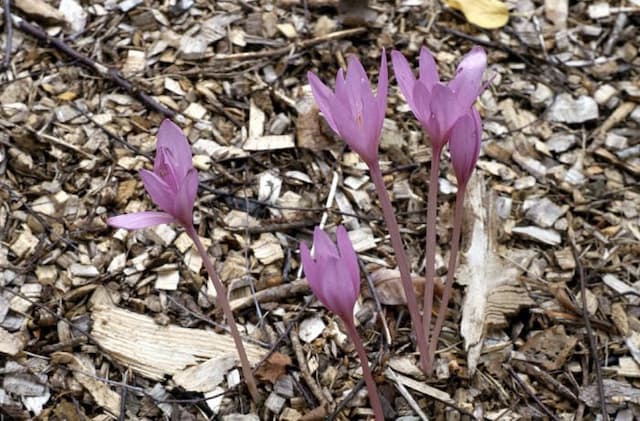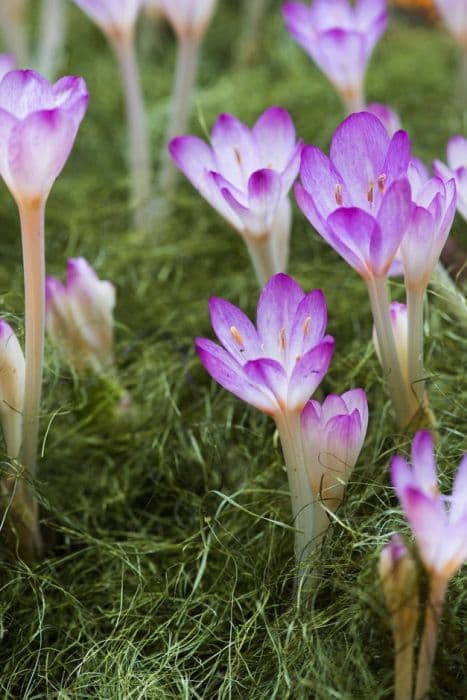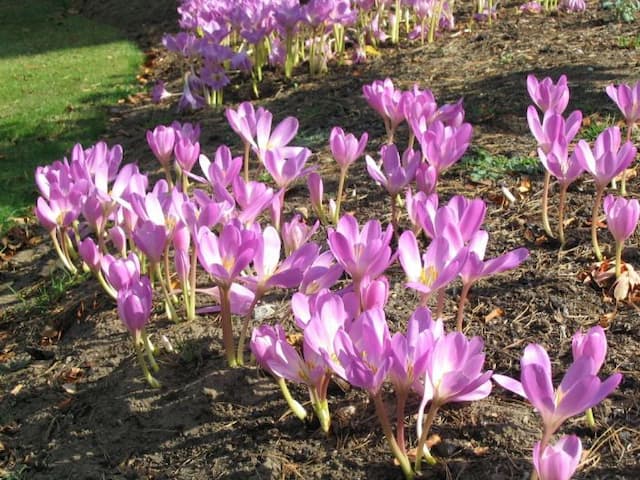Byzantine Glory Lily Colchicum × byzantinum Ker Gawl.

ABOUT
Commonly known as Byzantine gladiolus, the plant exhibits a unique and striking appearance. It has glossy, sword-shaped leaves that create a lush, green backdrop for its exceptional flowers. The blossoms themselves are eye-catching, appearing in a bold, conical shape. They boast a vivid color palette that ranges from light to deep purples, often with a hint of white near the base and throat, giving a delightful contrast. The flowers are arranged on tall, leafless stems, which emerge in an upright fashion and hold the blooms aloft like jewels on display. These blossoms have a soft, almost velvety texture, with each petal gently curving outwards, creating an inviting cupped form. In the center of the flowers, the stamens with their prominent anthers add a touch of elegance, presenting a contrasting color that stands out against the petals. Together, the foliage and flowers of the Byzantine gladiolus form a pleasing composition that is often used to add a dash of color to gardens. Without discussing specific dimensions, it is worth noting that the plant has a sizeable presence, which allows it to make a significant visual impact in the landscape.
About this plant
 Names
NamesFamily
Colchicaceae
Synonyms
Byzantine Gladiolus, Meadow Saffron, Autumn Crocus
Common names
Colchicum byzantinum Ker Gawl., Colchicum pulchellum G.Don, Colchicum cilicium Baker.
 Toxicity
ToxicityTo humans
The Autumn Crocus is highly toxic to humans if ingested. It contains colchicine, a potent compound that can cause a range of symptoms. Early signs of poisoning can include gastrointestinal distress such as nausea, vomiting, and diarrhea. As toxicity progresses, a person may experience more severe effects, including kidney failure, liver damage, respiratory failure, and multi-organ failure. Ingesting the plant can be potentially life-threatening and requires immediate medical attention.
To pets
The Autumn Crocus is also toxic to pets. Similar to its effects on humans, the colchicine in the plant can cause severe gastrointestinal upset, including vomiting and diarrhea, in cats and dogs. Other symptoms of toxicity can include drooling, abdominal pain, and blood in urine. More severe cases can progress to multiple organ failure and can be fatal. If you suspect your pet has ingested any part of the Autumn Crocus, seek veterinary care immediately.
 Characteristics
CharacteristicsLife cycle
Perennials
Foliage type
Deciduous
Color of leaves
Green
Flower color
Purple
Height
6 inches (15 cm)
Spread
3 inches (7.6 cm)
Plant type
Bulb
Hardiness zones
4
Native area
Mediterranean
Benefits
 General Benefits
General Benefits- Ornamental Value: Colchicum × byzantinum, commonly known as Autumn Crocus, adds aesthetic value to gardens with its attractive, vibrant purple-pink flowers that bloom in the autumn.
- Pollinator Attraction: Autumn Crocus flowers can attract bees and other pollinating insects, supporting local ecosystems.
- Low Maintenance: As a hardy perennial, it requires relatively little upkeep once established, making it suitable for gardeners of all skill levels.
- Drought Tolerance: Once established, it is resistant to periods of drought, making it suitable for water-wise landscapes.
- Deer and Rodent Resistance: The plant is typically resistant to grazing by deer and damage by rodents, preserving its visual appeal in the garden.
- Seasonal Interest: Blooming in late summer or early autumn, when many other plants have finished flowering, it provides color and interest during a time when gardens can start to look bare.
 Medical Properties
Medical Properties- Colchicum × byzantinum, commonly known as Byzantine Meadow Saffron, contains colchicine, a compound used to treat gout and familial Mediterranean fever.
- The plant has been historically used for its anti-inflammatory properties to alleviate swelling and pain associated with rheumatic conditions.
- It possesses antimitotic activity, meaning it can interfere with cell division, which is employed in the treatment of some cancers, albeit not without significant risks due to its toxicity.
 Air-purifying Qualities
Air-purifying QualitiesThis plant is not specifically known for air purifying qualities.
 Other Uses
Other Uses- Colchicum autumnale, commonly known as autumn crocus, can be used in fabric dyeing to provide a yellowish-brown or olive-green hue, although this is not a common practice due to the plant's toxicity.
- The autumn crocus is sometimes used in botanical illustration and photography classes to teach students due to its distinct shape and coloration.
- Garden designers may utilize autumn crocus for its fall blooming characteristic to provide an unexpected splash of color when most other plants are fading.
- Due to its hardiness, the autumn crocus is used in landscaping to create naturalizing effects in meadows, woodlands, or lawns.
- Some large-scale composting operations could add autumn crocus to their compost heaps for its potential to deter rodents, although care must be taken because of the plant's toxicity.
- Despite its poisonous nature, the autumn crocus has been historically used as rat poison.
- In areas with deer or rabbit problems, autumn crocus may be planted as it is typically avoided by these animals due to its toxicity.
- Enthusiasts of the autumn crocus may collect and exchange its seeds to preserve different varieties and cultivars of the plant.
- Autumn crocus is sometimes involved in gardening competitions for its distinctive blooms which appear without preceding foliage.
- Specialized horticultural therapy programs could utilize planting autumn crocus for its unique growing cycle, aiding in lessons about timing and patience in nature.
Interesting Facts
 Feng Shui
Feng ShuiThe Autumn Crocus is not used in Feng Shui practice.
 Zodiac Sign Compitability
Zodiac Sign CompitabilityThe Autumn Crocus is not used in astrology practice.
 Plant Symbolism
Plant Symbolism- Endurance and Survival: Colchicum × byzantinum, commonly known as autumn crocus, often blooms vigorously in the fall without leaves, which symbolizes endurance and the ability to thrive despite challenges.
- Rebirth and Renewal: As the autumn crocus emerges with its fresh flowers after a dormant period, it represents rebirth and the idea of new beginnings.
- Transition and Change: The flowering of the autumn crocus coincides with the transition from summer to fall, representing change and the natural cycle of life.
 Water
WaterAutumn crocus should be watered deeply but infrequently, allowing the soil to dry out somewhat between waterings. During the active growing season in fall, you may water the plant with about 1 inch of water per week, depending on rainfall and soil moisture. Cut back on watering after the blooms have faded and leaves begin to yellow, which signals the plant is entering dormancy. Overwatering can cause bulb rot, so it's essential to ensure good drainage. Drought conditions should be avoided especially when the plant is in bloom.
 Light
LightAutumn crocus thrives in partial shade to full sun conditions. The ideal location for the plant is where it receives morning sunlight and is protected from the intense heat of the afternoon sun. A spot under deciduous trees is suitable as it provides sunlight in the fall when the tree's leaves have dropped and shade during the hot summer months.
 Temperature
TemperatureAutumn crocus can tolerate a wide range of temperatures and is cold hardy in USDA zones 4 through 9. The bulbs require a period of winter chilling and can survive temperatures down to about -30°F. Ideally, they prefer daytime temperatures around 60°F to 75°F during their growth and blooming period in the fall.
 Pruning
PruningAutumn crocus does not require pruning in the traditional sense. However, spent flowers can be deadheaded to maintain a tidy appearance. Foliage should be allowed to die back naturally, as it provides the energy needed for the bulbs to flower the following season. The best time to remove foliage is once it has fully yellowed and withered, typically in late spring or early summer.
 Cleaning
CleaningAs needed
 Soil
SoilThe best soil mix for Byzantine gladiolus should be rich, well-draining, and neutral to slightly alkaline, with an ideal pH range between 6.5 and 7.5. A mixture containing garden soil, compost, and sharp sand or perlite to improve drainage can be ideal.
 Repotting
RepottingByzantine gladiolus typically does not need frequent repotting and can be left undisturbed for several years. Repot or divide the corms only when they become overcrowded, usually every 3 to 5 years.
 Humidity & Misting
Humidity & MistingByzantine gladiolus does not have specific humidity requirements and can adapt to a wide range of humidity levels as long as it is planted in well-draining soil and not overwatered.
 Suitable locations
Suitable locationsIndoor
Place in bright light, cool temperature, and well-draining soil.
Outdoor
Plant in full sun to partial shade in fertile soil.
Hardiness zone
4-9 USDA
 Life cycle
Life cycleThe life of Byzantine Gladiolus (Colchicum × byzantinum Ker Gawl.) begins with the germination of its seeds, usually in spring, although the plant more commonly reproduces asexually via corms. After germination or corm sprouting, foliage emerges and grows throughout the spring and into early summer; leaves are long and strappy, gathering energy through photosynthesis. The leaves die back during the hot summer months as the plant enters a period of dormancy, conserving energy within the corm. In late summer or early autumn, the plant breaks dormancy and flowers appear, blooming without the presence of foliage, showcasing strikingly large, lavender-pink, chalice-shaped flowers. After flowering, the plant sets seed in a capsule, gradually withering away as winter approaches; however, the life cycle is typically perpetuated by the corm, which remains dormant underground ready for the next cycle. With each cycle, the corms can multiply, leading to clumps of plants that can be divided for propagation.
 Propogation
PropogationPropogation time
Autumn
Colchicum × byzantinum, commonly known as Byzantine gladiolus, is typically propagated through division of the corms. The best time to do this is after the foliage has died back, usually in early summer. To propagate, carefully dig up the corms and gently pull apart any that are naturally separating. Plant the individual corms about 3 inches deep (approximately 7.6 centimeters) and around 4 to 6 inches apart (10 to 15 centimeters). Choosing a well-drained soil and a location with full sun to partial shade will help ensure the healthy growth of new plants. Water the newly planted corms moderately to help establish them. This method leverages the plant's natural reproductive strategies and results in a close copy of the parent plant.









